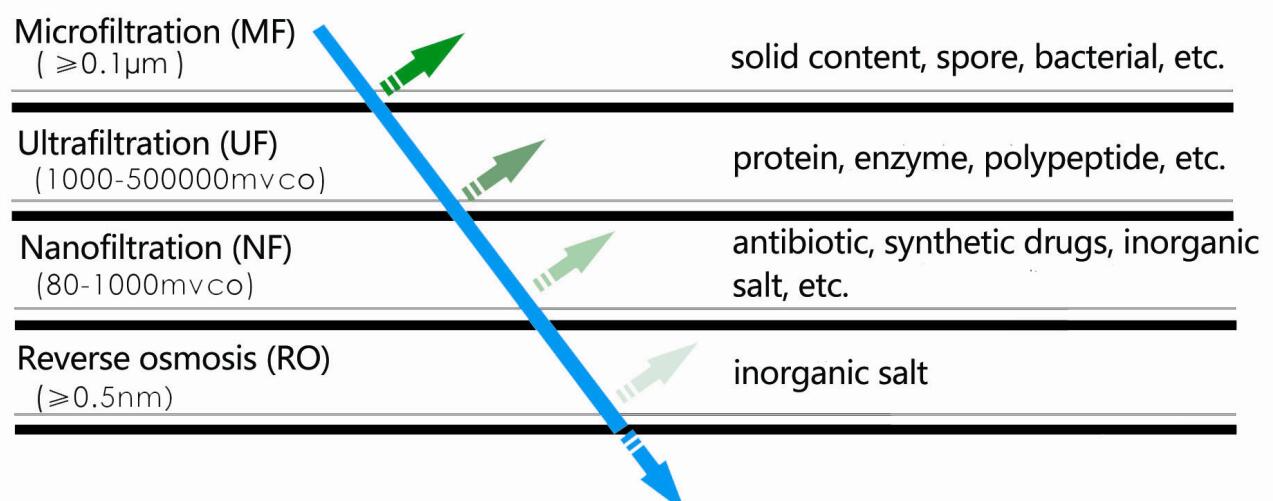

Principle of Membrane Separation Technology


Ceramic membrane technology


Spiral-wound membrane technology


Hollow fiber membrane technology


Electroosmosis
Membrane separation is a new separation concentration technology that features molecular-level separation of low temperature operation, energy conservation, high efficiency and precision. Membrane separation technology and equipment provided by Starmem cover roll, tubular, ceramics, hollow and other technologies and equipment, the separation accuracy covering microfiltration, ultrafiltration, nanofiltration and reverse osmosis, and are widely used in metallurgy, environmental protection, pharmaceutical, chemical engineering, food and other fields.

★Membrane is a selective separation barrier between two or more concentration phases, and uses the cross-flow filtration mode.
★Membrane is a composite material having selective separation function. Substances are separated by sieving method depending on the different physical properties of the mixture, or depending on the different chemical properties of the mixture.
★Membrane is used as the separation medium,by virtue of differences mass transfer rate in the membrane of each component of the multi-component fluid, the material is separated, purified and concentrated.

1)Microfiltration (MF): for substances whose cutoff diameter is more than 0.1 um usually as pre-filter of ultrafiltration, nanofiltration, reverse osmosis; large flux and low running cost.
2)Ultrafiltration (UF): for soluble substances whose molecular weight cutoff ranges between 1000 and 500,000; a membrane separation technology is capable of purification, separation, concentration of solutions; the ultrafiltration process can generally be understood as the screening process related to membrane pore size.
3)Nanofiltration (NF): for soluble substances whose molecular weight cutoff is 150 or more and diameter around 1nm; it is between ultrafiltration and reverse osmosis.
4)Reverse osmosis (RO): for water and some small molecules; mostly used for in pure water preparation, sea water desalination and other fields, also for concentration of amino acids and other small molecules.


1.Filtration sterilization of solution of biological fermentation and downstream separation and purification
2.Concentration and recycling of resin desorbed solution
3.Production and applications of pesticide liquid and powder
4.Filtration, purification, concentration, and production applications of Chinese medicine extracts
5.Recovery of crystallization mother liquor
6.Filtration and purification of antibiotics, vitamins, amino acids, organic acids, enzymes and other fermented liquid

1.Electroplating wastewater zero discharge and resource recycling
2.Mining and metallurgical wastewater treatment and recycling
3.Starch wastewater treatment
4.Acid, alkali wastewater treatment and recycling

1.Dairy products: wastewater treatment of whey, dairy production and processing applications, protein standardization
2.Clarification, decolorization and concentration of beverages and beer: fruit juice, tea drinks, beer, wine, etc.
3.Brewing products: clarification and filtration of soy sauce and vinegar
4.Carbohydrates: purification and enrichment of monosaccharide, starch sugar and other sugar
5.Filtration, purification and preparation of bioprotein, polypeptide, enzymic preparations and other broths
6.Purification and concentration of food additives

1.Licorice, yam extract, lentinan, stevia, xylose, xylitol, and grape seed extract
2.Mangosteen, salvia, pigments like gardenia yellow and gardenia blue, honeysuckle, rhodiola
3.Ginkgo biloba, aloe filtration, clarification and separation and extraction and separation of other plants.